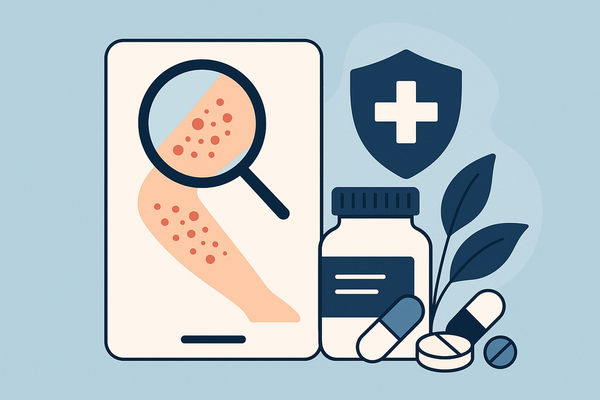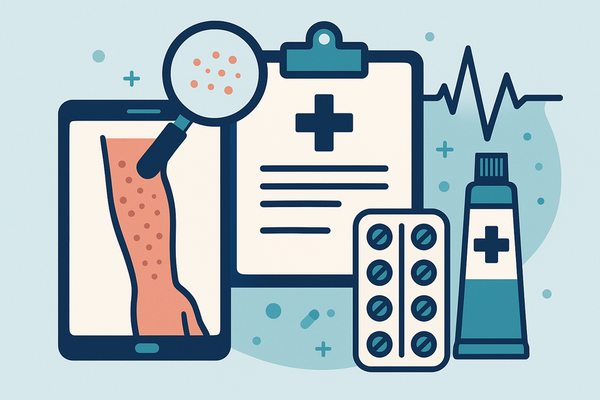Exploring the AI Dermatology Diagnostic Process: Machine Intelligence in Skin Condition Analysis
Uncover the AI dermatology diagnostic process and learn how machine intelligence identifies and classifies skin conditions with precision and speed.

Estimated reading time: 10 min read
Key Takeaways
- Comprehensive Workflow: AI analyzes clinical images, patient history, and contextual data to classify skin conditions.
- High Accuracy & Consistency: Convolutional neural networks often match or exceed dermatologist‐level performance while reducing variability.
- Essential Preprocessing: Image normalization, noise reduction, and feature extraction are critical for robust model performance across diverse skin tones.
- Real-World Impact: AI enables rapid triage, supports primary care, and extends specialist reach, though bias and regulatory hurdles remain.
Table of Contents
- Section 1: Understanding the AI Dermatology Diagnostic Process
- Section 2: The AI Dermatology Diagnostic Process Explained
- Section 3: Technical Insights Behind the AI Dermatology Diagnostic Process
- Section 4: Benefits and Challenges of AI in Dermatology
- Section 5: Case Studies and Real-World Applications
- Section 6: Future Trends and Evolution
- Conclusion
- FAQ
Section 1: Understanding the AI Dermatology Diagnostic Process
AI dermatology diagnostic process refers to the end-to-end workflow where artificial intelligence algorithms simulate expert decision-making by analyzing clinical images, patient history, and contextual data to identify and classify skin conditions. With clinician shortages and long wait times, these tools help deliver faster, precise assessments.
For a deeper look at how AI diagnoses rashes in clinical practice, see the detailed overview.
- Traditional diagnostic methods include:
- Visual inspection by a dermatologist
- Dermatoscopy (microscopic skin imaging)
- Patient interview and history review
- Histopathology (biopsy analysis)
- AI-enhanced workflows add:
- Automated image recognition
- Consistent lesion assessment
- Scalability for teledermatology and primary care
Section 2: The AI Dermatology Diagnostic Process Explained
This section breaks down each major step of the AI diagnostic pipeline.
Step 1 – Data Collection
- Capture high-resolution clinical photos under varied lighting and angles.
- Gather patient metadata: age, past skin issues, symptom duration, sun exposure.
- Extract information from electronic health records and questionnaires.
Step 2 – Preprocessing
- Normalize brightness and contrast for consistency.
- Reduce noise with Gaussian or median filters.
- Extract features using edge detectors (Sobel) and texture descriptors (Local Binary Patterns).
Step 3 – Model Training
- Train supervised models on datasets of 10,000+ labeled images.
- Employ CNN architectures (ResNet, Inception) for deep feature learning.
- Optimize via forward pass, cross-entropy loss, backpropagation, and the Adam optimizer.
- Continuously retrain with diverse cases to cover all skin tones.
Step 4 – Diagnosis and Interpretation
- Perform model inference to generate probability scores for candidate conditions.
- Create explainable heatmaps (Grad-CAM, saliency maps) to highlight diagnostic regions.
- Present a ranked list of diagnoses (e.g., eczema 85%, psoriasis 10%, other 5%) with image overlays.
Section 3: Technical Insights Behind the AI Dermatology Diagnostic Process
Machine Learning Models
- Convolutional Neural Networks (CNNs): Use convolutional and pooling layers to learn hierarchical skin-image features.
- Decision Tree Ensembles: Hybrid systems combine image features with non-image data (age, symptoms) for enhanced predictions.
Image Recognition Techniques
- Convert RGB images to HSV for accurate redness detection (erythema).
- Compute Haralick features for texture analysis (surface roughness).
- Measure border irregularity via compactness and fractal dimension.
For more on machine learning in skin analysis, explore the specialized review.
Training Challenges
- Dataset Bias: Underrepresentation of darker skin tones can degrade accuracy.
- Edge Cases: Rare conditions require human-in-the-loop labeling of outliers.
- Data Augmentation: Apply rotations, scaling, cropping, and color jitter to simulate variability and prevent overfitting.
Section 4: Benefits and Challenges of AI in Dermatology
Benefits of the AI Dermatology Diagnostic Process
- High Accuracy: Matches dermatologist performance on many conditions.
- Speed & Scalability: Enables real-time triage in telemedicine and primary care.
- Consistency: Reduces inter-observer variability and supports novice clinicians.
Challenges of the AI Dermatology Diagnostic Process
- Data Equity: Must address bias against underrepresented skin tones.
- Regulatory Hurdles: Requires multi-center trials and FDA/CE approvals.
- Ethical Considerations: Ensure privacy, informed consent, and algorithmic transparency.
Section 5: Case Studies and Real-World Applications of the AI Dermatology Diagnostic Process
Case Study 1: Non-Specialist Support
- An AI assistant provided differential diagnoses for 400+ conditions.
- Non-specialists improved accuracy by 20% with AI guidance.
Case Study 2: Clinic Integration
- Embedding AI into electronic health records reduced referrals by 30%.
- Early melanoma detection rates rose significantly.
Ongoing Trials
- Federated learning projects train models on decentralized hospital data to preserve privacy and expand skin-tone coverage.
Many clinicians and patients also leverage AI-powered tools like Rash Detector to get instant skin condition analysis. Below is a sample report generated by the app:

Section 6: Future Trends and Evolution of the AI Dermatology Diagnostic Process
- Multimodal Diagnostics: Combine clinical images with genomics, proteomics, and wearable‐sensor data for holistic skin health.
- Federated Learning: Share model updates instead of raw data across institutions for privacy-preserving training.
- Explainable AI (XAI): Build transparent models that provide human-readable reasons for each prediction.
- Assistive Triage Tools: Flag urgent cases, aid in resident training, and extend specialist reach to underserved regions.
Conclusion
The AI dermatology diagnostic process—from data collection and preprocessing to model training and inference—offers rapid, accurate skin condition assessments. While benefits include improved access, reduced wait times, and consistent triage, challenges around data bias, regulatory approval, and ethical implementation remain. Ongoing research, diverse datasets, and clinician-technologist collaboration will be key to realizing equitable, real‐world AI dermatology solutions.
FAQ
How accurate are AI dermatology diagnostic tools?
State-of-the-art AI models often match or exceed dermatologist performance in classifying common skin conditions under controlled settings.
Can AI handle diverse skin tones effectively?
With sufficiently diverse training data, AI can perform well across skin tones, but underrepresentation of darker skin in datasets remains a key challenge.
What are the main benefits of using AI in dermatology?
AI offers rapid triage, consistent lesion assessment, and extended specialist reach, particularly in telemedicine and primary‐care settings.
What ethical and regulatory considerations should be addressed?
Key issues include ensuring patient privacy, obtaining informed consent, maintaining transparent algorithms, and securing FDA/CE approvals.





